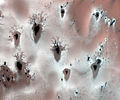Файл:Fractal defrosting patterns on Mars.jpg

Памер папярэдняга прагляду: 719 × 600 пікселяў. Іншыя разрозненні: 288 × 240 пікселяў | 575 × 480 пікселяў | 921 × 768 пікселяў | 1 227 × 1 024 пікселяў | 2 455 × 2 048 пікселяў | 3 157 × 2 634 пікселяў.
Арыгінальны файл (3 157 × 2 634 кропак, аб’ём файла: 7,99 MB, тып MIME: image/jpeg)
Гісторыя файла
Націснуць на даце з часам, каб паказаць файл, якім ён тады быў.
| Дата і час | Драбніца | Памеры | Удзельнік | Тлумачэнне | |
|---|---|---|---|---|---|
| актуальн. | 22:01, 28 студзеня 2014 |  | 3 157 × 2 634 (7,99 MB) | Tillman | {{Information |Description ={{en|1=This image is from the high latitudes in the Southern hemisphere, about half-way through southern spring. Just like on the Earth, the frost layer that accumulates over the winter will disappear as summer approache... |
Выкарыстанне файла
Наступная 1 старонка выкарыстоўвае гэты файл:
Глабальнае выкарыстанне файла
Гэты файл выкарыстоўваецца ў наступных вікі:
- Выкарыстанне ў en.wikipedia.org
- Выкарыстанне ў he.wikipedia.org
- Выкарыстанне ў th.wikipedia.org
- Выкарыстанне ў uk.wikipedia.org


